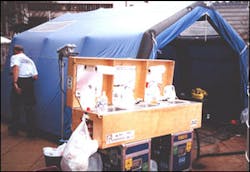Collapse Rescue 101: Using A Safety Plan
Operational work periods
In the extended event, having operational work periods is critical to ensuring the incident objectives are being accomplished. Typically, they are defined in 12 hour blocks, but due to the dynamics of your event, you may opt for 8 hour periods. For each work period, a detailed incident action plan is prepared. This plan is researched and prepared during the on-going work period for implementation in the next scheduled work period. The IAP includes such items as:
- Incident objectives
- Organization chart
- Division / group assignments
- Communications plan
- Area Map
- Medical plan
- Safety plan
The Safety Plan
When preparing the safety plan for the work period, there are many seemingly mundane items that need to be placed in the document. Some of these may seem a "no-brainer" but having them written, and perhaps more importantly, reviewed, before the start of the work period ensures the firefighters, who are becoming more tired as time goes on, pay attention to the little details that will prevent either an acute injury or chronic long-term illnesses.
Basic items such as:
- Level of personal protective equipment
- FD bunker gear or coveralls, medical gloves under the leather ones?
- Hearing protection
- Ear plugs or heavy duty covers?
- Eye protection
- Full faceshields, goggles or eyeglasses?
- Respiratory protection
- SCBA, Canister masks (which filter?), particle masks?
- Rest and rehab schedule
- Work for 2 hours, rest for 20 minutes? Hydration schedule?
Those are just the basics; there are many other items that must be in the plan:
- Evacuation signal
- Rally point, accountability system?
- Communications procedures
- Radio channel, cell phone number
- Gross decon procedures prior to returning to the base of operations
- Boot wash, overall body wash?
- Rehabilitation area
- Medical care, hydration, food, warmth, shelter, dry clothes, socks
- Hand Washing station
- Medical evacuation route
- Injury documentation procedure
- Rapid intervention team
- Personnel, tools, location, way to communicate.
- Anticipated weather for the work period
As you can see, a detailed Safety Plan includes more than on-site issues. For the collapse rescue operation, decon procedures are as important as level of PPE. Insuring the health and safety of your personnel include taking care of basic needs that are not generally thought of during day-to-day fire department operations.
